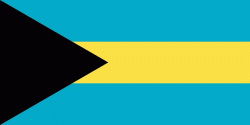Hope Town (Hope Town District)
Golf carts are the main mode of transportation, and most of the supplies for the area are brought in by barge each week. In Hope Town, neither cars nor golf carts are permitted in the main part of town. Only bicycles and walking are permitted. Though these laws are not strictly enforced, many of the streets in Hope Town are not wide enough to allow for golf cart traffic, or they are blocked off to the general public. Cars and golf carts are permitted on the outskirts of town. All the buildings that are built must adhere to Bahamian Architecture at the discretion of Town Planning. The seat of the Hope Town District Council is in Hope Town, and most of the meetings are held there.
Hope Town features one of the last operational kerosene-fueled lighthouses in the world. This lighthouse was built in 1862 and became operational two years later, it is striped horizontally red and white. Its light can be seen from 23 nmi away.
The Elbow Reef Lighthouse is one of only three manual lighthouses left in the world. It has a weight mechanism that has to be hand cranked every several hours to maintain the sequence of five white flashes every 15 seconds. The lamp burns kerosene oil with a wick and mantle, at the rate of 1 gallon per night. The light is then focused as it passes through the optics of a first order Fresnel lens which floats on a bed of mercury.
The Elbow Reef Lighthouse Society, (a Bahamian Non-Profit) is responsible for keeping the site true to its historical past as a fully-working, non-automated, aid to navigation. Entrusted by the Ministry of Transportation and Local Government, (responsible for the Port Department and Maritime Affairs), The ERLS is the Elbow Reef Lightstation's infrastructural custodian, tasked with the oversight and ongoing preservation and restoration of the Lighthouse and Lightstation itself which comprises the lighthouse tower, two lighthouse keeper's quarters, six outbuildings, one gift shoppe and the wharf/dock. Websites: elbowreeflighthousesociety.com and elbowreef.org
Map - Hope Town (Hope Town District)
Map
Country - The_Bahamas
 |
 |
The Bahama Islands were inhabited by the Lucayans, a branch of the Arawakan-speaking Taíno, for many centuries. Christopher Columbus was the first European to see the islands, making his first landfall in the "New World" in 1492 when he landed on the island of San Salvador. Later, the Spanish shipped the native Lucayans to and enslaved them on Hispaniola, after which the Bahama islands were mostly deserted from 1513 until 1648, nearly all native Bahamians having been forcibly removed for enslavement or having died of diseases that Europeans brought to the islands. In 1649, English colonists from Bermuda, known as the Eleutheran Adventurers, settled on the island of Eleuthera.
Currency / Language
| ISO | Currency | Symbol | Significant figures |
|---|---|---|---|
| BSD | Bahamian dollar | $ | 2 |
| ISO | Language |
|---|---|
| EN | English language |















